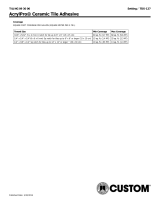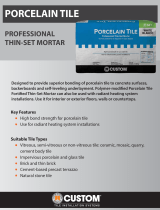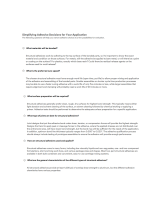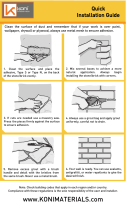Page is loading ...

MegaLite®RSUltimateRapidSettingCrackPreventionLargeFormatTileMortar/TDS120
1 Product Name
MegaLite®RSUltimateRapidSettingCrackPreventionLargeFormat
Tile Mortar
2 Manufacturer
Custom Building Products
Technical Services
10400 Pioneer Boulevard, Unit 3
Santa Fe Springs, CA 90670
Customer Support: 800-272-8786
Technical Services: 800-282-8786
Fax: 800- 200-7765
Email: [email protected]
custombuildingproducts.com
3 Product Description
A premium one part formula with the high, fast bond strengths and
flexibility to withstand horizontal movement to isolate substrate cracks.
For time-critical commercial and residential installations under the
most demanding requirements, capable of thin-set or medium bed
application up to 3/4" (19 mm) thick on horizontal surfaces after beat
in. Non-slump, medium-bed features provide the ultimate support for
large format tile and stone. No need for two part additives to meet
high bond and flexibility or compressive strength requirements. The
rapid setting formula allows grouting in less than 3 hours, traffic in 4
hours. A 30 lb (13.6 kg) bag covers the same area as a 50 lb (22.68
kg) bag of traditional mortar. Use for interior or exterior floors,
countertops and walls. Formulated with recycled material contributes
toLEED®certification.ExceedsANSIA118.4,A118.15andA118.11
without the need for additives.
Key Features
Fast curing - Grout in 3 hours, open for traffic in 4 hours
Unsurpassed bond strength and flexibility
Non-slump for floors, sag and slip resistant for walls
Lightweight - 30 lbs. covers the same area as 50 lbs. of traditional
mortar
Suitable Tile Types
Vitreous, semi-vitreous or non-vitreous tile: ceramic, mosaic, quarry,
cement body tile
Impervious porcelain and glass tile
Brick and Stone Veneer
Cement-based precast terrazzo
Natural stone tile
Suitable Substrates
Concrete, mortar beds, masonry, Portland cement plaster
WonderBoard®Lite, cement backerboards
Liquid applied waterproofing membranes such as RedGard® and
Custom®9240
CrackpreventionsheetmembranessuchasCrackBuster®Pro
Exterior Grade Plywood Substrates meeting deflection requirements
(interior residential and light commercial dry areas)
Gypsum wallboard (interior dry areas)
Existing ceramic tile (scarified)
Fully bonded sheet vinyl flooring (scarified)
Plastic laminates (scarified)
Cutback adhesive (see preparation instructions)
Composition of Product
Modified dry mortar, which is a proprietary blend of Portland cement,
inorganic aggregates, copolymers and chemicals.
Benefits of Product in the Installation
Sets quickly
Allows grouting in as little as 3 hours and light foot traffic in 4 hours
Maximum bond strength and flexibility
Isolates cracks
Non-slump medium bed for heavy tile and stone installations for floors
and walls
Exceeds ANSI A118.4, A118.15 and A118.11 standards without the
need for additives
Not formulated with silica sand
MegaLite®RSUltimateRapidSettingCrackPreventionLarge
Format Tile Mortar
Published Date: 4/11/2018

MegaLite®RSUltimateRapidSettingCrackPreventionLargeFormatTileMortar/TDS120
Limitations to the Product
Do not bond directly to hardwood, Luan plywood, particle board,
parquet, cushion or sponge-back vinyl flooring, metal, fiberglass,
plastic or OSB panels.
When setting moisture sensitive natural stone, cement or agglomerate
tileuseEBMLite™EpoxyBondingMortar100%SolidsorCEGLite™
100% Solids Commercial Epoxy Grout.
DonotusetoinstallresinbackedstoneuseEBMLite™EpoxyBonding
Mortar100%Solids,CEGLite™100%SolidsCommercialEpoxyGrout
orcontactCustom's®TechnicalServicesforrecommendations.
When setting glass tile larger than 6" x 6" (15 x 15 cm), contact
Custom's®TechnicalServicesforrecommendations.
When setting dimensional stone larger than 12" x 12" (30 x 30 cm),
contactCustom's®TechnicalServicesforrecommendationsregarding
subfloor deflection requirements.
Packaging
30 lb (13.6 kg) bag
Gray or white
4 Technical Data
Applicable Standards
American National Standards Institute (ANSI) - ANSI A108.5, A118.4,
A118.15 and A118.11 of the American National Standards for the
Installation of Ceramic Tile
ISO 13007-2
ASTM International (ASTM)
ASTM C109 Standard Test Method for Compressive Strength of
Hydraulic Cement Mortars (Using 2-in. or [50-mm] Cube Specimens)
ASTM C627 Standard Test Method for Evaluating Ceramic Floor Tile
Installation Systems Using the Robinson-Type Floor Tester
ResilientFloorCoveringInstitute—(RFCI)RecommendedWork
Practices for Removal of Resilient Floor Coverings
TileCouncilofNorthAmerica(TCNA)—TCNAHandbookforCeramic
Tile Installation, TCNA Method EJ171
Technical Chart
Property Test Method Requirement Typical Results
Pot Life 40 - 60 Minutes
Open
Time
A118.15
Section 5.3
> 20 Minutes Pass
4 Week Shear Bond Strength
Glazed
Wall Tile
A118.15
Section 7.1.2
> 450 psi 725 - 850 psi
(51.059.8kg/cm²)
Porcelain
Tile
A118.15
Section 7.2.5
> 400 psi 650 - 725 psi
(45.751.0kg/cm²)
Quarry
Tile to
Plywood
A118.11
Section 4.1.2
> 150 psi 350 - 425 psi
(24.629.9kg/cm²)
Sag on
Walls
A118.4
Section 4.6
< 1/16" Pass
Environmental Consideration
Custom®BuildingProductsiscommittedtoenvironmental
responsibility in both products produced and in manufacturing
practices.UseofthisproductcancontributetowardsLEED®v3
certification:
Up to 2 points towards MR Credit 5, Regional Materials
Up to 2 points towards MR Credit 4, Recycled Content
Upto1pointtowardsIEQCredit4.1,LowEmittingMaterials–
Adhesives & Sealants
5 Instructions
General Surface Prep
USE CHEMICAL-RESISTANT GLOVES, such as nitrile,
when handling product.
Surfaces must be structurally sound. Remove all grease, oil, dirt,
curing compounds, sealers, adhesives or any other contaminant that
would prevent a good bond. Glossy or painted surfaces must be
sanded, or abraded, and stripped of all contaminants. Concrete must
be cured 28 days and accept water penetration. Concrete must be free
of efflorescence and not subject to hydrostatic pressure. Concrete
slabs should have a coarse finish to enhance the bond. Plywood
flooring including those under resilient flooring must be structurally
soundand meet all ANSI and deflection requirements. For questions
about proper subfloor installation, call Technical Services. Smooth
concrete surfaces, existing glazed tile, terrazzo, or polished stone
should be scarified. Sheet vinyl must be well bonded and stripped of
old finish. Roughen the surface by sanding or abrading, then rinse and
allow to dry. Expansion joints should never be bridged with setting
material. Do not sand flooring materials containing asbestos. Ambient
temperatureshouldbemaintainedabove50°F(10°C)orbelow100°
F(38°C)for72hourstoachieveproperbond.
Bonding to Concrete Surfaces
Concrete or plaster must be fully cured and must accept water
penetration. Test by sprinkling water on various areas of the substrate.
If water penetrates, then a good bond can be achieved; if water
beads, surface contaminants are present, and loss of adhesion may
occur. Contaminants should be mechanically removed before
installation. Concrete must be free of efflorescence and not subject to
hydrostatic pressure. Concrete slabs should have a coarse finish to
enhance the bond. Smooth concrete slabs must be mechanically
abraded to achieve proper bond.
Bonding to Lightweight Cement and Gypsum Surfaces
Lightweight or gypsum based underlayments must obtain a minimum
2000 psi (13.8 MPa) compressive strength. The underlayment must be
sufficientlydryandproperlycuredtothemanufacturer’sspecifications
for permanent, non-moisture permeable coverings. Surfaces to be
tiled must be structurally sound and subject to deflection not to exceed
the current ANSI Standards. Surfaces shall be free of all grease, oil,
dirt, dust, curing compounds, waxes, sealers, efflorescence, or any
other foreign matter.
MegaLite®RSUltimateRapidSettingCrackPreventionLarge
Format Tile Mortar
Published Date: 4/11/2018

MegaLite®RSUltimateRapidSettingCrackPreventionLargeFormatTileMortar/TDS120
All Lightweight cement or Gypsum surfaces should be primed. with a
properly applied sealer or a primer coat of RedGard, consisting of 1
part RedGard diluted with 4 parts clean, cool water. Mix in a clean
bucket at low speed to obtain a lump free solution. The primer can be
brushed, rolled or sprayed to achieve an even coat. Apply the primer
coat to the floor at a rate of 300 ft2/gal (7.5 M2/L). Drying time
depends on site conditions, but is normally less than 1 hour. Extremely
porous surfaces may require 2 coats. At this point, RedGard can be
applied to the primed lightweight or gypsum based surface. Refer to
the individual product data sheet or packaging directions for application
instructions. Expansion joints must be installed in accordance with local
building codes and ANSI/TCNA guidelines. Refer to TCNA EJ171.
Bonding to Plywood Surfaces
Plywood floors, including those under resilient flooring, must be
structurally sound and must meet all ANSI A108.01 Part 3.4
requirements. Maximum allowable deflection: L/360 tile L/720 stone.
See TCNA F150-13 tile installations, TCNA F141-13 and F250-13 for
stone. For questions about proper subfloor installation requirements,
callCustom®TechnicalServices.
Bonding to Backerboards
As an alternative to an additional layer of plywood, WonderBoard Lite
backerboard may be installed over plywood subfloors for ceramic tile
installations. Refer to TCNA F144-13 tile installations and TCNA F-250-
13forstone.CallCustom®TechnicalServiceswheninstallingnatural
stone over plywood subfloor.
Bonding to Existing Surfacing Material
Existing Ceramic Tile, Resilient Flooring or Plastic Laminates: Resilient
flooring or plastic laminates must be well bonded, as well as clean and
free of all contaminates. Roughen the surface by sanding or scarifying;
rinse and allow to dry. Do not sand flooring that contains asbestos. For
existing well bonded ceramic tile, mechanically abrade the surface.
Rinse and allow to dry. When sanding, an approved respirator should
be used.
Bonding to Cutback Adhesive
Adhesive layers must be removed, as they reduce mortar bond
strength to cement surfaces. Use extreme caution; adhesives may
contain asbestos fibers. Do not sand or grind adhesive residue, as
harmful dust may result. Never use adhesive removers or solvents, as
they soften the adhesive and may cause it to penetrate into the
concrete. Adhesive residue must be wet-scraped to the finished
surface of the concrete, leaving only the transparent staining from the
glue. To determine desirable results, do a test bond area before
starting. Refer to the RFCI Pamphlet, "Recommended Work Practices
for Removal of Resilient Floor Coverings", for further information.
Movement Joint Placement
Movement joints are required for perimeters and other changes of
plane in all installations. Expansion joints and cold joints, as described
in ANSI A108.01, should never be bridged with setting material. They
must be brought through the tile work and filled with an appropriate
elastomericsealant,suchasCustom's®100%Silicone.Contact
Custom's®TechnicalServicesforthepropertreatmentofcontrolor
saw cut joints. Refer to TCNA EJ171, F125 and F125A.
Mixing Ratios
Mix 5.75 - 6 qts (5.4 - 5.7 L) clean water per 30 lb (13.6 kg) bag of
mortar.
Mixing Procedures
Mix by hand or use a low 150-200 RPM speed 1/2" (13 mm) drill to
achieve a smooth, paste-like consistency. Let the mixture slake or
stand 3 minutes; stir again and use. Stir occasionally, but do not add
more water. When properly mixed, troweled ridges will stand without
slump.
Application of Product
Installation must conform to ANSI A108.5. Use a properly-sized notch
trowel to ensure proper coverage under tiles. Using the flat side of the
trowel, apply a skim coat of mortar to the surface. With the notch side
ofthetrowelheldata45°angle,applyadditionalmortartothe
surface, combing in one direction. Press the tile firmly into place in a
perpendicular motion across ridges, moving back and forth. The
perpendicular motion flattens ridges and closes valleys, allowing
maximum coverage. With some tile, back-buttering is advisable. Adjust
the tile promptly and beat it in with a beating block and rubber mallet.
Periodically pull up a tile and check the back to ensure proper adhesive
coverage. If the material has skinned over (not sticky to the touch),
recomb with the notch trowel; if too dry, remove and replace the dry
material with fresh material. Thin-Set Mortar should not be used to fill
low spots in the flooring. Mortar thickness should be less than 3/4"
when beat in.
Curing of Product
Curing time is affected by ambient and surface temperatures and
humidity. Use the following as a guideline. Allow 3 hours before
grouting, 4 hours before light traffic, and 3 days before heavy or
vehicular traffic. Before exposure to heavy or vehicular traffic, assure
assemblyisrated“HeavyorExtraHeavy”perTCNAService
Requirements. As necessary, use plywood or other load distributing
protection when moving heavy equipment across tiled assembly.
Submerged installations must cure for 14 days before filling with
water.
Cleaning of equipment
Clean with water before the material dries.
Storage
Store in a cool dry area.
Health Precautions
This product contains Portland cement and free silica. Avoid eye
contact or prolonged contact with skin. Wash thoroughly after
handling. If eye contact occurs, flush with water for 15 minutes and
consult a physician. Do not breathe dust; wear a NIOSH approved
respirator.
Conformance to Building Codes
Installation must comply with the requirements of all applicable local,
state and federal code jurisdictions.
MegaLite®RSUltimateRapidSettingCrackPreventionLarge
Format Tile Mortar
Published Date: 4/11/2018

MegaLite®RSUltimateRapidSettingCrackPreventionLargeFormatTileMortar/TDS120
6 Availability & Cost
Item Code Size Color Package
MLRSG30 30 lb (13.6 kg) Gray Bag
MLRSW30 30 lb (13.6 kg) White Bag
* This item available by special order only.
7 Product Warranty
Obtain the applicable LIMITED PRODUCT WARRANTY at
www.custombuildingproducts.com/product-warranty or send a written
request to Custom Building Products, Inc., Five Concourse Parkway,
Atlanta, GA 30328, USA. Manufactured under the authority of Custom
BuildingProducts,Inc.©2017QuikreteInternational,Inc.
WhenMegaLite®RapidSettingCrackPreventionMortarisusedasa
part of a qualifying full installation system of CUSTOM products, the
installation can qualify for up to a lifetime system warranty. CUSTOM
will repair and/or replace, at its discretion, the affected area of the
system. For more information, find details and limitations to this
warranty at custombuildingproducts.com.
8 Product Maintenance
Properly installed product requires no special maintenance.
9 Technical Services Information
For technical assistance, contact Custom technical services at 800-282-
8786 or visit custombuildingproducts.com.
10 Filing System
Additional product information is available from the manufacturer upon
request.
Expected Wear
Properly installed tile will last for more than 60 years.
Related Products
Prism®UltimatePerformanceGrout
Polyblend®SandedGrout
MegaLite®RSUltimateRapidSettingCrackPreventionLarge
Format Tile Mortar
Published Date: 4/11/2018

MegaLite®RSUltimateRapidSettingCrackPreventionLargeFormatTileMortar/TDS120
Coverage
SQUARE FOOT COVERAGE PER 30 LB BAG (SQUARE METER PER 13.6 KG)
Trowel Size Min Coverage Max Coverage
Longest side of tile less than 8" use 1/4" x 1/4" x 1/4" (6 x 6 x 6 mm) Square-Notch 100sq.ft.(9.3M²) 110sq.ft.(10.2M²)
Longest side of tile 8" to 15" use 1/4" x 3/8" x 1/4" (6 x 9.5 x 6 mm) Square-Notch 70sq.ft.(6.5M²) 77sq.ft.(7.2M²)
Longest side of tile more than 15"+ use 1/2" x 1/2" x 1/2" (13 x 13 x 13 mm) Square-Notch 50sq.ft.(4.6M²) 55sq.ft.(5.1M²)
Longestsideoftilemorethan15"+use3/4"×9/16"×3/8"(19×14×9.5mm)UNotch 40sq.ft.(33.7M²) 44sq.ft.(4.1M²)
Recommended minimum coverage (80% for dry areas and 95% for wet areas and exteriors). Back buttering may be necessary.
Note that mortar coverage does not include backbuttering tiles. When backbuttering, consider the tile underside pattern and depth to estimate thickness
and usage to add to your estimate.
Chart for estimating purposes. Coverage may vary based on installation practices and jobsite conditions. For more sizes, use the material calculator at
CustomBuildingProducts.com or contact CUSTOM Technical Services at 800-282-8786.
MegaLite®RSUltimateRapidSettingCrackPreventionLarge
Format Tile Mortar
Published Date: 4/11/2018
/







